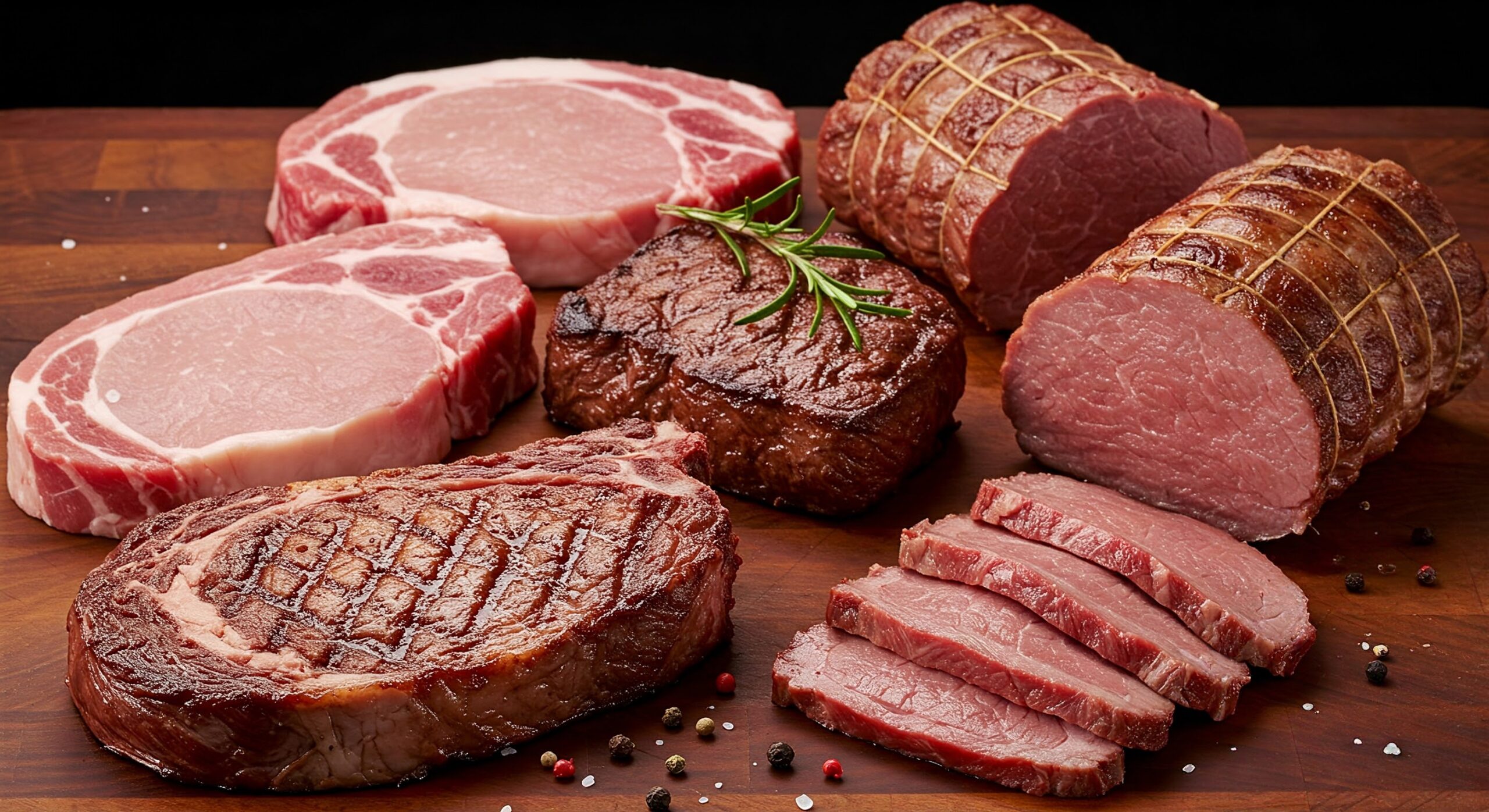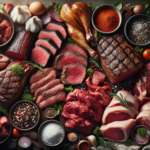The Synergy of Carnivore and Ketosis
The carnivore diet and ketosis are a powerful combination for those seeking to optimize their health and achieve efficient fat adaptation. While many people are familiar with the concept of ketogenic diets, the carnivore diet takes this approach a step further by focusing exclusively on animal products. This creates a naturally ketogenic environment, allowing your body to become incredibly efficient at burning fat for fuel.
What is the Carnivore Diet?
The carnivore diet is, at its core, a diet consisting entirely of animal products. This means that all plant-based foods are eliminated. The focus is on:
- Types of meat: This includes red meat (beef, lamb, bison, etc.), poultry (chicken, turkey, duck), fish (salmon, tuna, mackerel, etc.), and organ meats (liver, kidney, heart, etc.).
- Animal fats: Tallow, lard, butter, and ghee are all excellent sources of energy on a carnivore diet.
- Limited dairy: If tolerated, some individuals include high-fat, low-lactose dairy options like heavy cream or hard cheeses. However, dairy is not a core component for everyone and should be approached with caution, assessing individual tolerance.
- Exclusion of all plant-based foods: This means no fruits, vegetables, grains, legumes, nuts, or seeds.
The Rationale Behind a Meat-Based Diet
There are several reasons why people choose a meat-based diet:
- Evolutionary arguments: Some proponents argue that humans evolved to thrive on a diet primarily consisting of animal products, pointing to the diets of our ancestors. While this is a complex topic, it’s a key part of the carnivore philosophy.
- Nutrient density of animal products: Animal products are incredibly nutrient-dense, providing a wide range of essential vitamins, minerals, and amino acids in highly bioavailable forms.
- Elimination of potential plant-based irritants: Many plants contain compounds (sometimes referred to as anti-nutrients) that can interfere with nutrient absorption or cause digestive issues in some individuals. The carnivore diet eliminates these potential irritants.
Understanding Ketosis: Your Body’s Fat-Burning Mode
What is Ketosis?
Ketosis is a metabolic state where your body, deprived of sufficient glucose from carbohydrates, switches to using ketones as its primary fuel source. Ketones are produced from the breakdown of fat.
- Glucose vs. ketone bodies as fuel: Typically, your body uses glucose (from carbohydrates) for energy. In ketosis, your liver converts fat into ketone bodies, which are then used by your cells, including your brain, for energy.
- The process of ketone production (lipolysis, beta-oxidation): This process involves lipolysis (the breakdown of stored fat into fatty acids) and beta-oxidation (the process of breaking down fatty acids into ketones).
- Measuring ketones: Ketones can be measured through blood, breath, or urine tests. Blood tests are generally considered the most accurate.
The Ketogenic Diet: A High-Fat, Low-Carb Approach
A ketogenic diet is any dietary approach that restricts carbohydrates sufficiently to induce ketosis.
- Macronutrient ratios typically associated with a Ketogenic Diet: A standard ketogenic diet usually involves a macronutrient ratio of approximately 70-80% fat, 20-25% protein, and 5-10% carbohydrates.
- The role of carbohydrate restriction in inducing ketosis: By drastically reducing carbohydrate intake, you deplete your body’s glycogen stores (stored glucose), forcing it to switch to fat for fuel.
- Differences between a general ketogenic diet and the carnivore diet: While both diets induce ketosis, a general ketogenic diet allows for low-carb plant foods like leafy greens, nuts, and seeds. The carnivore diet, being exclusively animal-based, is a much stricter and more restrictive form of a ketogenic diet.
The Carnivore Diet: A Naturally Ketogenic Approach
Why the Carnivore Diet Leads to Ketosis
The carnivore diet is inherently ketogenic due to its composition:
- The near-zero carbohydrate intake of a meat-based diet: Meat contains virtually no carbohydrates.
- Animal protein and fat as the primary macronutrients: These are the building blocks of the carnivore diet, providing the body with the necessary energy and nutrients.
- How the body shifts to fat as its primary fuel source: With no carbohydrates to rely on, your body rapidly adapts to using fat, and subsequently ketones, for energy.
Comparing Carnivore and Standard Ketogenic Diets
- Similarities in achieving ketosis: Both diets achieve ketosis through carbohydrate restriction.
- Differences in food choices and potential benefits: The carnivore diet is more restrictive, but some proponents believe it offers additional benefits due to the complete elimination of plant-based foods, potentially reducing inflammation and improving gut health.
- Addressing concerns about variety on a Carnivore Diet: While seemingly limited, variety can be achieved through different cuts of meat, organ meats, and different cooking methods.
Fat Adaptation: Becoming a Fat-Burning Machine
What is Fat Adaptation?
Fat adaptation is the metabolic shift where your body becomes highly efficient at using fat as its primary fuel source. It goes beyond simply being in ketosis.
- Defining fat adaptation as the metabolic shift to efficiently using fat for fuel: It’s the process of optimizing your cellular machinery to utilize fat effectively.
- The difference between being in ketosis and being fully fat-adapted: You can be in ketosis (producing ketones) without being fully fat-adapted. Fat adaptation is a deeper level of metabolic flexibility.
- The timeframe for achieving fat adaptation (variability among individuals): This can vary greatly, from a few weeks to several months, depending on individual factors like genetics, previous diet, and activity levels.
Signs and Symptoms of Fat Adaptation
- Increased energy levels and mental clarity: Many people report sustained energy throughout the day and improved cognitive function once fat-adapted.
- Reduced cravings for carbohydrates: Your body no longer relies on glucose spikes, leading to fewer cravings.
- Improved athletic performance (endurance): Fat is a more sustainable fuel source for endurance activities.
- Stable blood sugar levels: Without the constant influx of carbohydrates, blood sugar levels tend to stabilize.
The Role of the Carnivore Diet in Accelerating Fat Adaptation
- Consistent, very-low carbohydrate intake: This ensures a constant state of ketosis and promotes fat adaptation.
- High intake of bioavailable nutrients supporting metabolic processes: Animal products provide the essential nutrients needed for efficient fat metabolism.
- Eliminating potential obstacles to fat adaptation (e.g., hidden carbs): The carnivore diet removes any potential sources of hidden carbohydrates that might hinder the process.
Benefits of Combining Carnivore and Ketosis
Enhanced Weight Loss and Fat Loss
- Mechanisms of fat loss on a combined approach: Increased fat burning, reduced appetite, and improved metabolic efficiency all contribute to weight loss.
- Addressing potential plateaus on other diets: The carnivore diet can help break through weight loss plateaus experienced on other diets.
Improved Metabolic Health Markers
- Impact on blood sugar and insulin sensitivity: The carnivore diet can significantly improve blood sugar control and insulin sensitivity.
- Potential benefits for cholesterol and triglycerides: While individual results vary, many people experience improvements in their lipid profiles.
- Reducing inflammation: Eliminating potentially inflammatory plant compounds can contribute to reduced inflammation.
Mental Clarity and Cognitive Function
- Ketones as a fuel source for the brain: Ketones can be a more efficient and stable fuel source for the brain than glucose.
- Anecdotal reports and potential mechanisms: Many individuals report improved focus, concentration, and overall cognitive function on a carnivore diet.
Potential Benefits for Specific Health Conditions
- Autoimmune diseases: Some individuals with autoimmune conditions report improvements in symptoms on a carnivore diet, potentially due to the elimination of dietary triggers.
- Digestive issues: The carnivore diet can be beneficial for individuals with certain digestive issues, as it eliminates many common gut irritants.
Potential Challenges and Considerations
The Keto Flu and Adaptation Period
- Common symptoms and how to manage them: The keto flu is a collection of symptoms (headache, fatigue, nausea) that can occur during the initial adaptation phase. These are usually temporary and can be managed by increasing electrolyte intake.
- Electrolyte balance (sodium, potassium, magnesium): It’s crucial to replenish electrolytes, especially sodium, potassium, and magnesium, as they are often lost during the initial stages of ketosis.
- Importance of hydration: Drinking plenty of water is essential to help flush out waste products and support the transition.
Nutrient Considerations on a Carnivore Diet
- Addressing potential deficiencies (e.g., Vitamin C, fiber): While animal products are nutrient-dense, concerns about certain nutrients like Vitamin C and fiber are often raised.
- The role of organ meats in providing a wider range of nutrients: Organ meats are incredibly rich in vitamins and minerals, and incorporating them can help ensure a wider range of nutrient intake.
- The debate surrounding the necessity of fiber: While fiber is often touted as essential, the necessity of fiber on a carnivore diet is debated. Many individuals report improved digestion without it.
Social and Practical Challenges
- Eating out and social gatherings: It can be challenging to find carnivore-friendly options when eating out. Planning ahead is key.
- Meal planning and preparation: While the diet is simple, some meal planning and preparation are still required.
- Long-term sustainability: The long-term sustainability of the carnivore diet is a topic of ongoing discussion. It’s essential to listen to your body and make adjustments as needed.
Listening to your body
- Importance of individual responses: Everyone responds differently to dietary changes. It’s crucial to pay attention to how your body feels and adjust accordingly.
- Adjusting intake as needed: You may need to adjust your fat and protein intake based on your individual needs and activity levels.
Getting Started with a Carnivore and Ketogenic Approach
Transitioning to a Carnivore Diet
- Gradual vs. immediate approach: Some people prefer a gradual transition, slowly eliminating plant foods, while others jump in immediately. Choose the approach that feels best for you.
- Tips for minimizing initial side effects: Stay hydrated, replenish electrolytes, and get enough rest.
Essential Foods for a Carnivore Diet
- Prioritizing high-quality meat and animal fats: Choose grass-fed and pasture-raised options whenever possible.
- Choosing cuts of meat based on preference and budget: Experiment with different cuts of meat to find what you enjoy and what fits your budget.
- Incorporating organ meats (if desired): Start with small amounts of organ meats if you’re new to them.
Monitoring Ketone Levels and Tracking Progress
- Methods for measuring ketones: Blood, breath, or urine testing can help you monitor your ketone levels.
- Keeping a food journal and tracking symptoms: This can help you identify any potential issues and track your progress.
- Adjusting the diet based on individual results: Be prepared to make adjustments to your diet based on your ketone levels and how you feel.
Seeking Professional Guidance
- Consult a healthcare provider: It is always best to consult with your Doctor or other healthcare provider.
- Nutritional therapist: A nutritional therapist with experience in carnivore diets can provide personalized guidance.
Frequently Asked Questions
Is the carnivore diet safe for everyone?
While many people thrive on a carnivore diet, it’s not suitable for everyone. Individuals with certain medical conditions, such as kidney disease, should consult with their healthcare provider before making significant dietary changes. It’s always best to seek professional medical advice.
How do I get enough vitamins and minerals on a carnivore diet?
Animal products, particularly organ meats, are incredibly nutrient-dense. Prioritizing a variety of meats, including organ meats, can help ensure adequate nutrient intake. Some individuals may choose to supplement certain nutrients, but this should be done under the guidance of a healthcare professional.
Will I experience the keto flu?
Some people experience the keto flu during the initial adaptation phase. This is usually temporary and can be managed by increasing electrolyte intake (sodium, potassium, magnesium) and staying well-hydrated.
Can I eat any fruits or vegetables on a carnivore diet?
No, the carnivore diet strictly excludes all plant-based foods, including fruits and vegetables.
How long does it take to become fat-adapted?
The time frame for fat adaptation varies among individuals. It can take anywhere from a few weeks to several months. Consistency and listening to your body are key.
Is the carnivore diet sustainable long-term?
Many individuals have successfully maintained a carnivore diet long-term. However, it’s essential to listen to your body, monitor your health, and make adjustments as needed. Long-term sustainability depends on individual factors and preferences.
Conclusion
The carnivore diet, with its inherent ketogenic nature, offers a powerful path to fat adaptation and potential health benefits.
By focusing exclusively on nutrient-dense animal products, you can effectively eliminate carbohydrates, inducing ketosis and prompting your body to become a highly efficient fat-burning machine.
This can lead to enhanced weight loss, improved metabolic health, increased mental clarity, and potential benefits for various health conditions.
While challenges exist, understanding the principles of the carnivore diet and ketosis, along with careful planning and listening to your body, can unlock significant improvements in your overall well-being.


